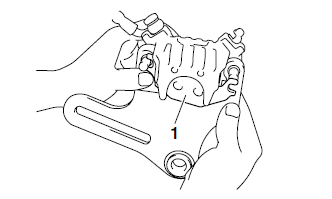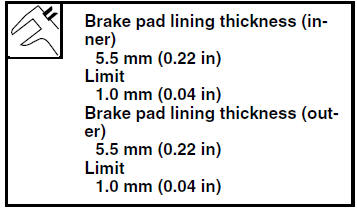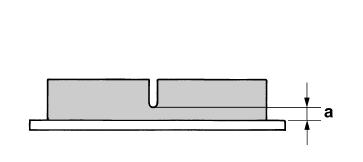Yamaha YZF-R125 Service Manual: Replacing the rear brake pads
NOTE:
When replacing the brake pads, it is not necessary to disconnect the brake hose or disassemble the brake caliper.
1. Remove:
- Brake pads
- Brake pad spring
NOTE:
To remove the inner brake pad "1", push down on the brake caliper bracket so that there is space to remove the brake pad.

2. Measure:
Brake pad wear limit "a"
Out of specification → Replace the brake
pads as a set. 

3. Install:
- Brake pad spring

- Brake pads

NOTE:
Always install new brake pads and a new brake pad spring as a set.
a. Connect a clear plastic hose tightly to the bleed screw. Put the other end of the hose into an open container.

b. Loosen the bleed screw and push the brake caliper piston into the brake caliper with your finger.
c. Tighten the bleed screw. 
d. Install a new brake pad spring "1" and new brake pads.
NOTE:
Install the brake pad spring as shown.

4. Install:
- Brake pad retaining bolts
- Brake caliper

5. Install:
- Rear wheel Refer to "REAR WHEEL" on page 4-12.
6. Check:
- Brake fluid level
Below the minimum level mark "a"
 Add the
Add the
recommended brake fluid to the proper level.Refer to "CHECKING THE BRAKE FLUID LEVEL" on page 3-18.

7. Check:
- Brake pedal operation
Soft or spongy feeling
 Bleed
Bleed
the brake system.Refer to "BLEEDING THE HYDRAULIC BRAKE SYSTEM" on page 3-20.
 Checking the rear brake disc
Checking the rear brake disc
1. Remove:
Rear wheel
Refer to "REAR WHEEL" on page 4-12.
2. Check:
Brake disc
Damage/galling → Replace.
3. Measure:
Brake disc deflection
Out of specification → Correc ...
 Removing the rear brake caliper
Removing the rear brake caliper
NOTE:
Before disassembling the brake caliper, drain
the brake fluid from the entire brake system.
1. Remove:
Union bolt "1"
Copper washers "2"
Brake hose "3"
NOTE:
Put the end of th ...
Other materials:
Multi-function display
1. Multi-function display
2. "RESET/SELECT" button
The multi-function display is equipped with the
following:
a speedometer (which shows the riding speed)
an odometer (which shows the total distance
traveled)
two tripmeters (which show the distance traveled
since they were last ...
Installing the fuel hose
1. Install:
Fuel hose
Fuel hose connector cover
CAUTION:When installing the fuel hose, make sure
that
it is securely connected, and that the fuel
hose connector cover is in the correct position,
otherwise the fuel hose will not be properly
installed.
NOTE:
W ...
Checking the rear brake master cylinder
1. Check:
Brake master cylinder
Damage/scratches/wear Replace.
Brake fluid delivery passages
(brake master cylinder body)
Obstruction Blow out with
compressed air.
2. Check:
Brake master cylinder kit
Damage/scratches/wear Replace.
3. Check:
Brake fluid reservoir
Cracks/ ...
